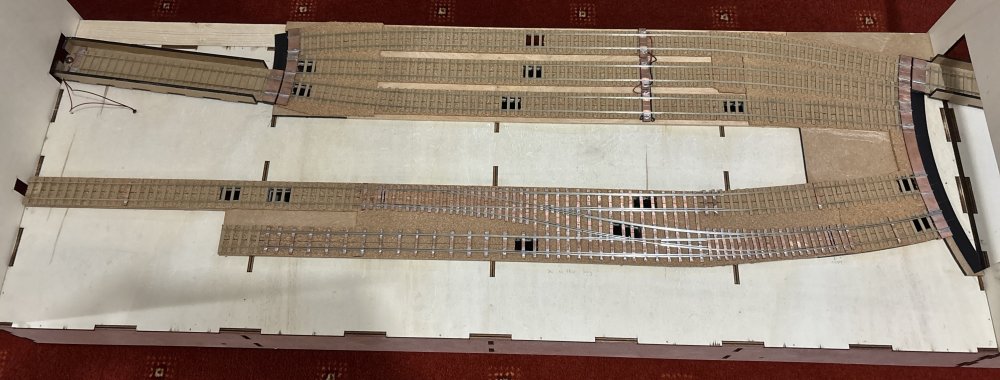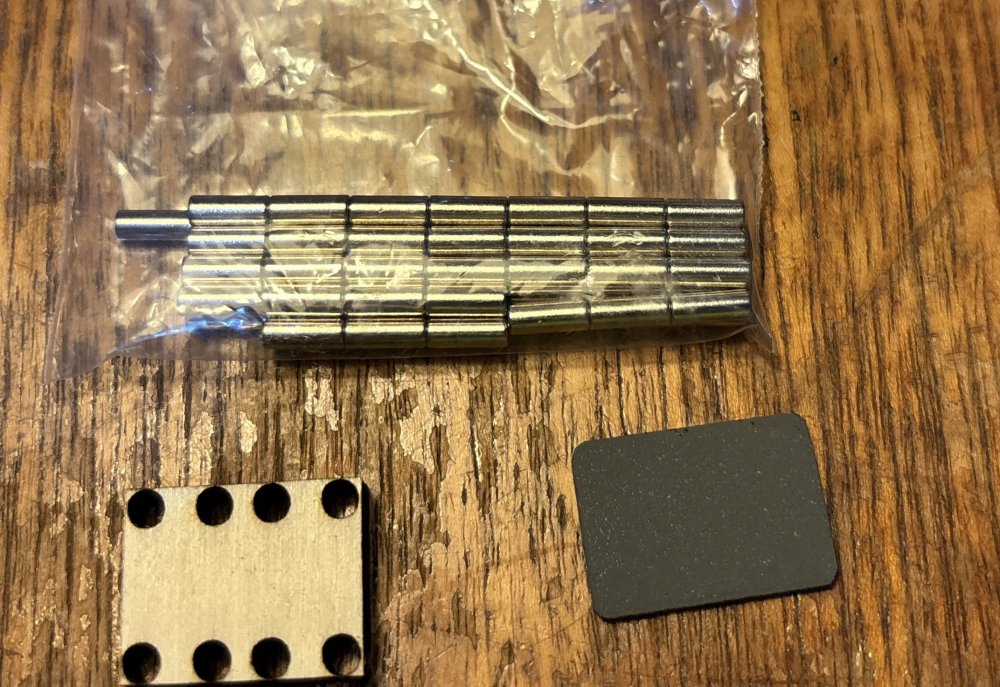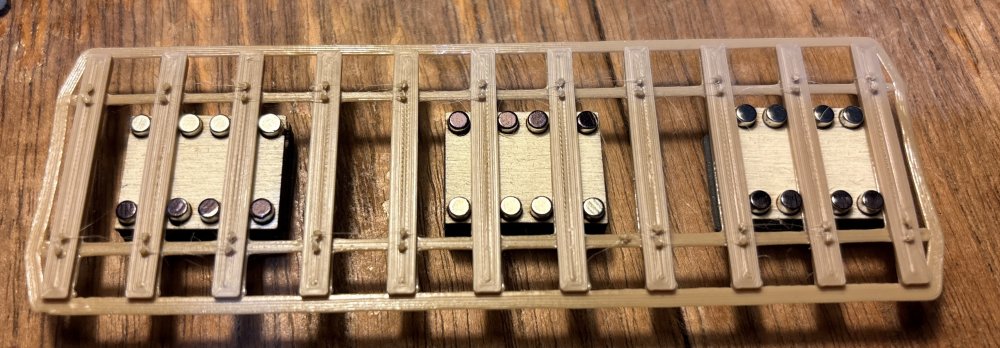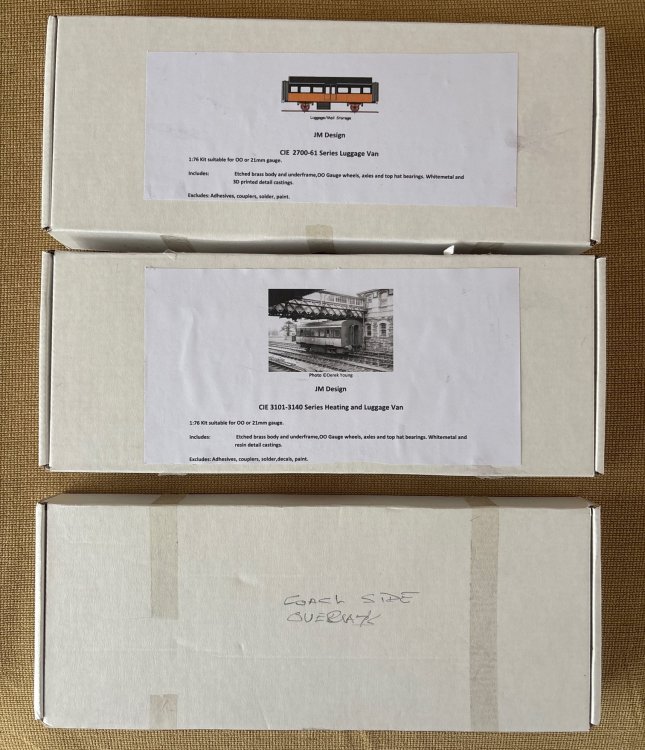
Mol_PMB
Members-
Posts
2,281 -
Joined
-
Last visited
-
Days Won
125
Content Type
Profiles
Forums
Events
Gallery
Everything posted by Mol_PMB
-
"Voiding the Warranty" - Mol's experiments in 21mm gauge
Mol_PMB replied to Mol_PMB's topic in Irish Models
Hopefully my ebay ‘bargain’ loco kit (the 650 class ex-MGWR 2-4-0) will also turn up this week. I need to see which variants can be built from the kit I’ve bought. Having read through many of @Mayner ‘s threads on the development and building of the kit, I get the impression that the kit evolved and they may not all have offered the same variant options. The good thing is that I can choose between at least three late survivors that worked railtours (653, 654 and 655) which had different variants of cab spectacles, firebox, smokebox, dome and indeed a host of other details. I think 654 was one of the locos painted black (is there a list of those, @jhb171achill ?) but they all seem to have ended their lives in brown filth. Matching the weathering on 655’s tender would be fun! Here’s 654 which has surely been freshly repainted for its railtour duty: A comparison with a similar view of J15 193 also on railtour duty. This one is grey, but 654 looks truly black: (pics from Ernie - thanks) -
"Voiding the Warranty" - Mol's experiments in 21mm gauge
Mol_PMB replied to Mol_PMB's topic in Irish Models
The worm had moved along the motor shaft. I think I was relying on a press fit rather than any glue. I have got the loco running again though it doesn’t seem quite as smooth - possibly the worm wheel is slightly damaged. One of the hornblocks also seems to have stiffened up in the horns, and needs a fettle. Anyway, back on the layout I am having some of those undesired uncoupling events. I picked a different set of wagons to those I used previously and some are more sensitive than others. Partly due to how free-running they are, but perhaps also influenced by whether they have NEM pockets or Kadee draft boxes. More experiments needed! I may try adjusting the magnet positions. But I think all that is a job for the tail end of the coming week. I’ve got a few busy days at work coming up. -
"Voiding the Warranty" - Mol's experiments in 21mm gauge
Mol_PMB replied to Mol_PMB's topic in Irish Models
Well, some success and some failure. I’ve completed the point operating rods, and the microswitches for the frog polarity. I’ve had E410 running around the layout for a bit, initially with no problems at all. Then it got something jammed in a set of points, and it stopped with a graunch. I think one of the rail sweeps was a bit low and stuck in a checkrail flangeway. Now E410 doesn’t move and makes unpleasant noises. I think something has come adrift in the gearbox, or possibly a gear has stripped some of its teeth. I need to take it apart and see what’s wrong. So testing will have to go on hold for a while, as this is my only 21mm gauge loco at present. Frustrating. -
"Voiding the Warranty" - Mol's experiments in 21mm gauge
Mol_PMB replied to Mol_PMB's topic in Irish Models
Some of my uncouplers are on embedded track (set into concrete on the prototype). There's just no space, maybe half a millimetre between the coupler tail and the rail height. -
"Voiding the Warranty" - Mol's experiments in 21mm gauge
Mol_PMB replied to Mol_PMB's topic in Irish Models
Interesting idea. Tricky for Kadees because there’s almost no clearance between the coupler tails and the rail height. In my case I’m also hoping to avoid the hand of god appearing too much. -
Wonderful! Those trains look perfectly at home.
-
Interesting to see the Lobitos oil storage tanks on the right. I don't recall seeing any photos of Lobitos rail tank wagons in Ireland, although they had some in GB. Later, Lobitos merged with Burmah, who of course did have rail tank wagons in Ireland, though the terminal was in Cork and I don't think they ever ventured north of the border.
-
"Voiding the Warranty" - Mol's experiments in 21mm gauge
Mol_PMB replied to Mol_PMB's topic in Irish Models
I have found that the magnets can move a very free-running wagon in that way, but most of my wagons seem OK. Again I will do some more experiments and fine-tuning. Another solution is to give the very free-running wagons a little more resistance, e.g. with a small piece of foam stuck underneath, rubbing lightly against a wheelset. Not ideal for a large layout with heavy trains, but for a shunting layout with a maximum train length of 3 wagons it could be a fair solution. That would also help to keep couplings taut when trains are being hauled, thereby reducing the problem of unintended uncoupling. -
"Voiding the Warranty" - Mol's experiments in 21mm gauge
Mol_PMB replied to Mol_PMB's topic in Irish Models
That’s interesting to hear. I certainly want to do plenty of testing before fixing magnets in place permanently. The simple tests I’ve done with just a couple of wagons seem to work ok in all modes, but I can imagine if there’s a bit of bunching in a train being hauled then they might uncouple. I can play with various parameters including the number of magnets, the height they are set at, and the lateral and longitudinal spacing. I can do all of those by tweaking the dimensions of the plywood block in CAD and laser-cutting them. One more drastic possibility would be to physically raise and lower the magnet assembly on a lever. On another layout I used the Kadee electromagnets, which work well but they are huge and power-hungry. I’ve never had much luck with the flat plate magnet type that sits on top of the sleepers. I’ll post an update on how I get on with my experiments. -
June 2025, vol 31 no 217
-
Interesting. There was an article about the Opera Specials in a recent IRRS journal. I only once saw the exec carriages in that livery, in a train at Heuston.
-
That could be a ‘when the real thing looks like a model’ thread. The trees are reasonably well modelled but only partly disguise the join between the layout and the backscene - the latter seems to have faded in the sun while the layout uses a very garish colour palette. There’s been no effort to weather the rolling stock, and painting a sheet of ripple glass a bilious yellow colour does not make a realistic river! On the plus side, the bridge is very nicely modelled, but it’s let down by the layout presentation with poorly-placed strip lighting.
-
"Voiding the Warranty" - Mol's experiments in 21mm gauge
Mol_PMB replied to Mol_PMB's topic in Irish Models
Some layout progress to report from the last couple of days. Firstly, all the track is now fixed down and the sector plate interfaces completed. Under the board I have done most of the wiring. It’s just the switched feeds to the two frogs that I haven’t dealt with. I’m planning to use some simple dowel rods to work the points, and to have them activate a microswitch to change the frog polarity. That may be a job for tomorrow. Secondly, I had been doing some experiments with uncouplers for the Kadees using rows of miniature magnets (an idea I saw on RMweb). This seems to work quite well - here are a couple of photos of my trial piece (not on the layout, this is made from oddments). The magnetic field is stronger with a steel plate underneath to connect the bottom poles of the magnets. So for the production version I have made some little ‘dominoes’ (or are they licorice allsorts?). The ingredients are a plywood block with holes in (laser-cut), 8 little magnets, and a steel plate: When complete they look like this: By adjusting the hole spacing in the wooden block I can make them fit between the sleepers of the track: The tops of the magnets are level with the sleepers so once the track is painted and ballasted they will be unobtrusive. They are also cheap - 100 magnets cost me less than £10 including postage, and the other materials cost me nothing. I have a few more of these to make, and will then get them installed on the layout. By making them as separate units I hope I can fine-tune their position to optimise performance. Some time in the coming week I hope to be testing the track, points and magnets with E410 and a few wagons. -
It's also worth noting that Rapido have collaborated with a 3D printing firm to offer alternative bodies for one of their other recently announced locos. Narrow Lines - 009 Kerr, Stuart and Co. Sirdar 0-4-0 (Long Tank) - Rapido Trains - RMweb Presumably they shared their CAD for the chassis/mechanism in that case.
-
T2 is rather chunkier. Again, shorter bogie wheelbase and smaller bogie wheels, but 2' longer at the back than the C2 / C12. Driving wheel dia 5'9" Bogie and trailing wheel dia not listed Wheelbase 5'3" + 6'10.5" + 8'3" + 8'0" Length over buffers not listed As for the GSWR, the earlier locos were 37-38, 317-320: Driving wheel dia 5'8.5" Bogie wheel dia 3'0" Trailing wheel dia 3'9" Wheelbase 5'3" + 6'5" + 7'9" + 6'0" Length over buffers 35'11" The later batch were 27, 30-32: Driving wheel dia 5'8.5" Bogie wheel dia 3'0" Trailing wheel dia 3'9" Wheelbase 5'3" + 5'5" + 7'11" + 6'6" Length over buffers 31'. I don't seem to have many dimensions for the DSER locos in my library.
-
For those wondering what it might fit, key chassis dimensions of the real C2 / C12 are as follows: Driving wheel dia 5'7.5" Bogie and trailing wheel dia 3'7.5" Wheelbase 6'3" + 6'9" + 8'3" + 6'0" = 27'3" Length over buffers 36'6.25". Front overhang 4'0.25", rear 5'3". (Source: GN loco history volume 3a, Groves) It's not a million miles out from a GSWR 4-4-2T, but that had much smaller bogie wheels, a shorter bogie wheelbase and was generally shorter at the front end.
-
British locos and stock that can be disguised as Irish
Mol_PMB replied to Westcorkrailway's topic in Irish Models
The 'difficult' bits with handrails are drilling the holes in the right place, and forming the wire to the right shape. That can be helped by: Put dimples in the 3D print to guide where the holes need to be. Provide a separate (also 3D printed) part which is a bending jig for complex shaped handrails. Then you can get the shape right before fitting it to the model. -
British locos and stock that can be disguised as Irish
Mol_PMB replied to Westcorkrailway's topic in Irish Models
IRM and Murphy have both produced models with the correct Irish buffer spacing, equally they have both produced other models with GB narrower buffer spacing. It depends which model you pick! 3D printed buffers are often fragile, and easily broken. Ideally I wouldn't want the buffers included on the main body print at all - I would prefer to fit separate buffers (usually cast metal). Let the modeller drill the holes for them at their preferred spacing. You could probably include a couple of small 'dimples' at each spacing to help start the drill in the right place - the other dimple would end up hidden behind the buffer housing. -
British locos and stock that can be disguised as Irish
Mol_PMB replied to Westcorkrailway's topic in Irish Models
Agreed. The modern desire for DCC, sound and heavy weight has encouraged the manufacturers to fill every available bit of space inside the bodyshell, especially for smaller steam locos. That means that a modern chassis is less likely to fit a different shape body. However, with older chassis there's something else to watch out for - are they actually accurate to the original prototype? It's all very well finding that your J11 has the same wheelbase and wheel diameter as a GWR 57xx, but does the older model 57xx have the right dimensions? For older models manufacturers used the same chassis for several different prototypes and the dimensions may well be a compromise. Also note - a 57xx is a couple of feet longer than a J11 - can the ends of the chassis be trimmed off without losing anything vital? Will the mechanism still be hidden? At least with a 57xx there are several different models to choose from, including Hornby, Mainline, Bachmann and Accurascale. My gut feel is that it's best to stick to the true prototype dimensions as much as possible. Once you start changing the proportions of the loco then it soon looks wrong. But this is an area where every individual modeller has their own level of 'good enough'. -
I reckon Santa will be glad of his furry costume after a day on a 450 in wintertime! Good to hear tickets have sold well.
-
I spotted this on the IRRS website, ideal for all of those trying to justify mixing GB and Irish prototypes on their layout: When I first started work in Derby in the late 1990s I recall we also had some Iarnrod Eireann Mk2 and Mk3 coaches come in for crash damage repairs.
-
A reminder of the IRRS Manchester meeting tonight, in person and online: “Railways of the IOM” by Alistair Renfrew - Irish Railway Record Society It's a Manx theme this time - of course there was much in common between the Irish and Manx narrow gauge steam-worked lines, but they were both pioneers of electric railways too. I think the talk will cover all the rail-borne Manx transport systems over the years. I'm intending to be there, should be a good show.
-
Alan, that’s some very nice work indeed. It’s great to see how you have arranged the compensation and the motor/gearbox too. I look forward to following your progress with this.
-
"Voiding the Warranty" - Mol's experiments in 21mm gauge
Mol_PMB replied to Mol_PMB's topic in Irish Models
It was quite a big class, for Ireland, with 20 locos originally. Most were withdrawn in the late 1950s but 6 survived into the early 1960s. 653 and 654 almost saw the end of steam, being withdrawn in 1963. They weren't confined to former MGWR lines - there are also numerous photos of them working on the DSER section, like this one at Bray (also from Ernie): For me, assuming I ever get round to building it, the loco will have to be a special visitor on a railtour. A J15 would have been a more logical purchase really! -
"Voiding the Warranty" - Mol's experiments in 21mm gauge
Mol_PMB replied to Mol_PMB's topic in Irish Models
My parcel from the Antipodes has arrived safely - many thanks to @Mayner for these. Hopefully they will soon be joined by another JM design kit that I have acquired second-hand: That will give me far too many projects for the winter season, but hopefully I can make progress on some of them. I've been having an initial look at photos of the 650 class and it seems there was much variation between locos in the class. Individual locos also seem to have had various different types of boiler and smokebox over the years, as well as modifications to springing, cabs, chimneys and domes, and tender details. It's a minefield! When I get the kit I'll have to see which variants it caters for, and then choose a suitable prototype. Preferred options at present based on withdrawal dates and the number of good photos available are 653, 654 and 655. Pics from Ernie:
.png.c363cdf5c3fb7955cd92a55eb6dbbae0.png)











